EXERCISE-6.1
P1. Fill in the blanks using correct word given in the brackets:−
(i) All circles are __________. (congruent, similar)
(ii) All squares are __________. (similar, congruent)
(iii) All __________ triangles are similar. (isosceles, equilateral)
(iv) Two polygons of the same number of sides are similar, if (a) their corresponding angles are __________ and (b) their corresponding sides are __________. (equal, proportional)
Sol. (i) Similar
(ii) Similar
(iii) Equilateral
(iv) (a) Equal
(b) Proportional
P2. Give two different examples of pair of (i) Similar figures (ii) Non-similar figures
Sol. (i) Two equilateral triangles with sides 1 cm and 2 cm
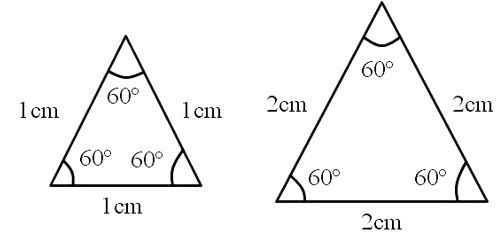
Two squares with sides 1 cm and 2 cm
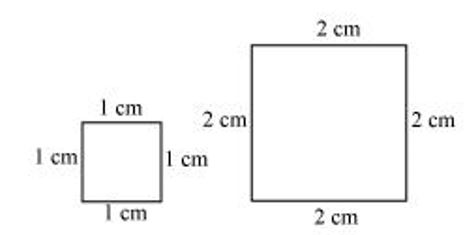
(ii) Trapezium and square
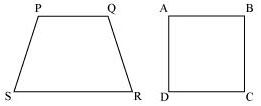
Triangle and parallelogram
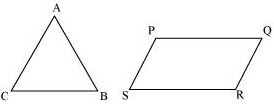
P3. State whether the following quadrilaterals are similar or not: 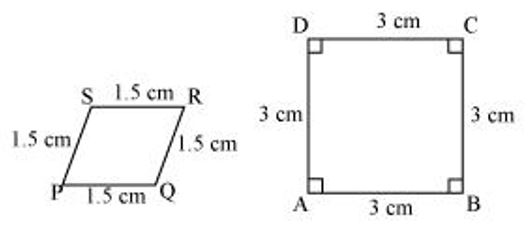
Sol. Quadrilateral PQRS and ABCD are not similar as their corresponding sides are proportional, i.e. 1:2, but their corresponding angles are not equal.
EXERCISE-6.2
P1. In figure.6.17. (i) and (ii), DE || BC. Find EC in (i) and AD in (ii).
(i) 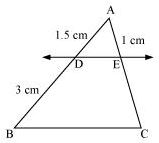
(ii) 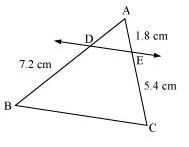
Sol. (i) 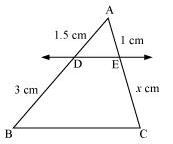
Let EC = x cm
It is given that DE || BC.
By using basic proportionality theorem, we obtain
x = 2
EC = 2cm
(ii) 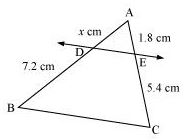
Let AD = x cm
It is given that DE || BC.
By using basic proportionality theorem, we obtain
x = 2.4
AD = 2.4 cm
P2. E and F are points on the sides PQ and PR respectively of a ΔPQR. For each of the following cases, state whether EF || QR.
(i) PE = 3.9 cm, EQ = 3 cm, PF = 3.6 cm and FR = 2.4 cm
(ii) PE = 4 cm, QE = 4.5 cm, PF = 8 cm and RF = 9 cm
(iii) PQ = 1.28 cm, PR = 2.56 cm, PE = 0.18 cm and PF = 0.63 cm
Sol. (i) 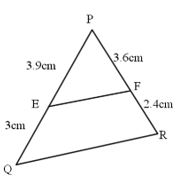
Given that, PE = 3.9 cm, EQ = 3 cm, PF = 3.6 cm, FR = 2.4 cm
Hence,
Therefore, EF is not parallel to QR.
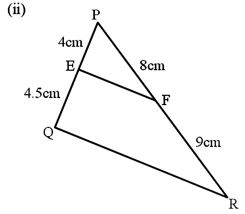
PE = 4 cm, QE = 4.5 cm, PF = 8 cm, RF = 9 cm
Hence,
Therefore, EF is parallel to QR.
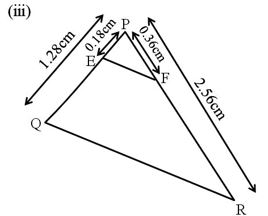
PQ = 1.28 cm, PR = 2.56 cm, PE = 0.18 cm, PF = 0.36 cm
Hence,
Therefore, EF is parallel to QR.
P3. In the following figure, if LM || CB and LN || CD, prove that
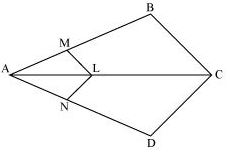
Sol. In the given figure, LM || CB
By using basic proportionality theorem, we obtain
Similarly, LN || CD
__________ (ii)
From (i) and (ii), we obtain
P4. In the following figure, DE || AC and DF || AE. Prove that
.
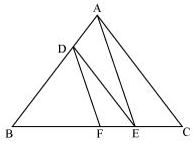
Sol. In ΔABC, DE || AC
(Basic Proportionality Theorem) ……….. (i)

In ΔABC, DE || AE
(Basic Proportionality Theorem) ……… (ii)
From (i) and (ii), we obtain
P5. In the following figure, DE || OQ and DF || OR, show that EF || QR.
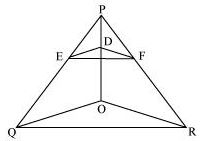
Sol. In ΔPOQ, DE || OQ
(Basic Proportionality Theorem) ………. (i)
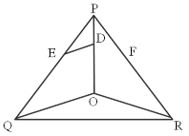
In ΔPOQ, DF || OR
(Basic Proportionality Theorem) ……….. (ii)
From (i) and (ii), we obtain
EF || QR (Converse of basic proportionality theorem)
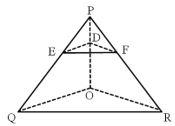
P6. In the following figure, A, B and C are points on OP, OQ and OR respectively such that AB || PQ and AC || PR. Show that BC || QR.
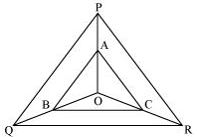
Sol. In ΔPOQ, AB || PQ
(Basic Proportionality Theorem) ……….. (i)
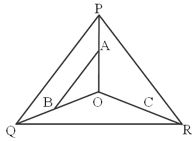
In ΔPOQ, AC || PR
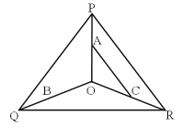
(Basic Proportionality Theorem) … (ii)
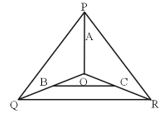
From (i) and (ii), we obtain
BC || QR
(By the converse of basic proportionality theorem)
P7. Using Basic proportionality theorem, prove that a line drawn through the mid-points of one side of a triangle parallel to another side bisects the third side. (Recall that you have proved it in Class IX).
Sol. Consider the given figure in which PQ is a line segment drawn through the mid-point P of line AB, such that PQ ||BC.
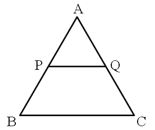
By using basic proportionality theorem, we obtain
(P is the mid-point of AB, AP = PB)
AQ = QC
or, Q is the mid-point of AC.
P8. Using Converse of basic proportionality theorem, prove that the line joining the mid-points of any two sides of a triangle is parallel to the third side. (Recall that you have done it in Class IX).
Sol. Consider the given figure in which PQ is a line segment joining the mid-points P and Q of line AB and AC respectively.
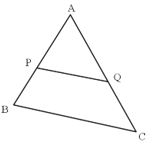
i.e., AP = PB and AQ = QC
It can be observed that
and
Hence, by using basic proportionality theorem, we obtain PQ || BC.
P9. ABCD is a trapezium in which AB || DC and its diagonals intersect each other at the point O. Show that .
Sol. Draw a line EF through point O, such that EF || CD.

In ΔADC, EO || CD
By using basic proportionality theorem, we obtain
_________ (1)
In ΔABD, OE || AB
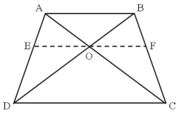
So, by using basic proportionality theorem, we obtain
_________ (2)
From equations (1) and (2), we obtain
P10. The diagonals of a quadrilateral ABCD intersect each other at the point O such that Show that ABCD is a trapezium.
Sol. Let us consider the following figure for the given question.
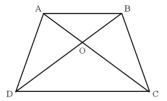
Draw a line OE || AB
In ΔABD, OE || AB
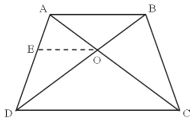
By using basic proportionality theorem, we obtain
_________ (1)
However, it is given that
_________ (2)
From equations (1) and (2), we obtain
⇒ EO || DC [By the converse of basic proportionality theorem]
⇒ AB || OE || DC
⇒ AB || CD
ABCD is a trapezium.
EXERCISE-6.3
P1. State which pairs of triangles in the following figure are similar? Write the similarity criterion used by you for answering the P and also write the pairs of similar triangles in the symbolic form:
(i) 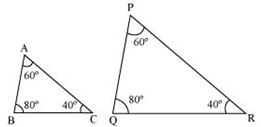
(ii) 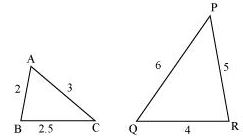
(iii) 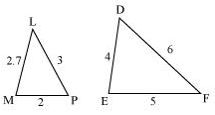
(iv) 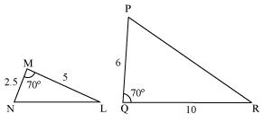
(v) 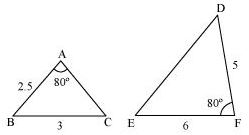
(vi) 
Sol. (i) ∠A = ∠P = 60°
∠B = ∠Q = 80°
∠C = ∠R = 40°
Therefore, ΔABC ∼ ΔPQR [By AAA similarity criterion]
ΔABC ~ ΔQRP [By SSS similarity criterion]
(iii) The given triangles are not similar as the corresponding sides are not proportional.
(iv) The given triangles are not similar as the corresponding sides are not proportional.
(v) The given triangles are not similar as the corresponding sides are not proportional.
(vi) In ΔDEF,
∠D + ∠E + ∠F = 180º
(Sum of the measures of the angles of a triangle is 180º.)
70º + 80º + ∠F = 180º
∠F = 30º
Similarly, in ΔPQR,
∠P + ∠Q + ∠R = 180º
(Sum of the measures of the angles of a triangle is 180º.)
∠P + 80º + 30º = 180º
∠P = 70º
In ΔDEF and ΔPQR,
∠D = ∠P (Each 70°)
∠E = ∠Q (Each 80°)
∠F = ∠R (Each 30°)
ΔDEF ∼ ΔPQR [By AAA similarity criterion]
P2. In the following figure, ΔODC ∼ ΔOBA, ∠BOC = 125° and ∠CDO = 70°. Find ∠DOC, ∠DCO and ∠OAB
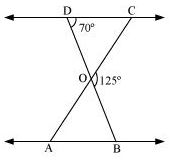
Sol. DOB is a straight line.
∴ ∠DOC + ∠COB = 180°
⇒ ∠DOC = 180° − 125° = 55°
In ΔDOC,
∠DCO + ∠CDO + ∠DOC = 180°
(Sum of the measures of the angles of a triangle is 180º.)
⇒ ∠DCO + 70º + 55º = 180°
⇒ ∠DCO = 55°
It is given that ΔODC ∼ ΔOBA.
∴ ∠OAB = ∠ OCD [Corresponding angles are equal in similar triangles.]
⇒ ∠OAB = 55°
P3. Diagonals AC and BD of a trapezium ABCD with AB || DC intersect each other at the point O. Using a similarity criterion for two triangles, show that
Sol. DOB is a straight line.
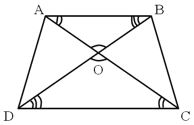
In ΔDOC and ΔBOA,
∠CDO = ∠ABO [Alternate interior angles as AB || CD]
∠DCO = ∠BAO [Alternate interior angles as AB || CD]
∠DOC = ∠BOA [Vertically opposite angles]
ΔDOC ∼ ΔBOA [AAA similarity criterion]
[Corresponding sides are proportional]
P4. In the following figure, and ∠1 = ∠2 Show that ΔPQS ~ ΔTQR
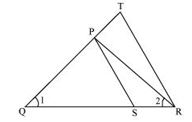
Sol. 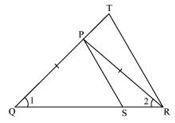
In ΔPQR, ∠PQR = ∠PRQ
PQ = PR ___________ (i)
Given,
Using (i), we obtain
_____________ (ii)
In ΔPQR, ΔTQR,
[Using (ii)]
∠Q = ∠Q
ΔPQS ~ ΔTQR [SAS similarity criterion]
P5. S and T are point on sides PR and QR of ΔPQR such that ∠P = ∠RTS. Show that ΔRPQ ∼ ΔRTS.
Sol. 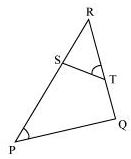
In ΔRPQ and ΔRST,
∠RTS = ∠QPS (Given)
∠R = ∠R (Common angle)
ΔRPQ ∼ ΔRTS (By AA similarity criterion)
P6. In the following figure, if ΔABE ≅ ΔACD, show that ΔADE ∼ ΔABC.
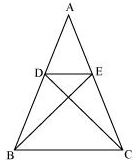
Sol. It is given that ΔABE ≅ ΔACD.
AB = AC [By CPCT] (1)
And, AD = AE [By CPCT] (2)
In ΔADE and ΔABC,
[Dividing equation (2) by (1)]
∠A = ∠A [Common angle]
ΔADE ∼ ΔABC [By SAS similarity criterion]
P7. In the following figure, altitudes AD and CE of ΔABC intersect each other at the point P. Show that:
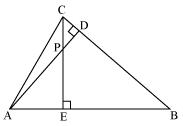
(i) ΔAEP ∼ ΔCDP
(ii) ΔABD ∼ ΔCBE
(iii) ΔAEP ∼ ΔADB
(iv) ΔPDC ∼ ΔBEC
Sol. (i) 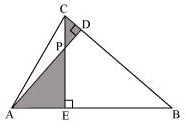
In ΔAEP and ΔCDP,
∠AEP = ∠CDP (Each 90°)
∠APE = ∠CPD (Vertically opposite angles)
Hence, by using AA similarity criterion,
ΔAEP ∼ ΔCDP
(ii) 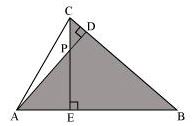
In ΔABD and ΔCBE,
∠ADB = ∠CEB (Each 90°)
∠ABD = ∠CBE (Common)
Hence, by using AA similarity criterion,
ΔABD ∼ ΔCBE
(iii) 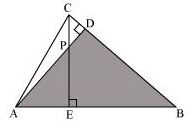
In ΔAEP and ΔADB,
∠AEP = ∠ADB (Each 90°)
∠PAE = ∠DAB (Common)
Hence, by using AA similarity criterion,
ΔAEP ∼ ΔADB
(iv) 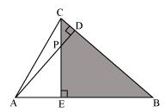
In ΔPDC and ΔBEC,
∠PDC = ∠BEC (Each 90°)
∠PCD = ∠BCE (Common angle)
Hence, by using AA similarity criterion,
ΔPDC ∼ ΔBEC
P8. E is a point on the side AD produced of a parallelogram ABCD and BE intersects CD at F. Show that ΔABE ∼ ΔCFB
Sol. 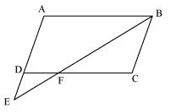
In ΔABE and ΔCFB,
∠A = ∠C (Opposite angles of a parallelogram)
∠AEB = ∠CBF (Alternate interior angles as AE || BC)
ΔABE ∼ ΔCFB (By AA similarity criterion)
P9. In the following figure, ABC and AMP are two right triangles, right angled at B and M respectively, prove that:
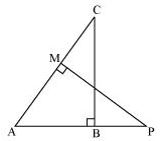
(i) ΔABC ∼ ΔAMP
(ii)
Sol In ΔABC and ΔAMP,
∠ABC = ∠AMP (Each 90°)
∠A = ∠A (Common)
ΔABC ∼ ΔAMP (By AA similarity criterion)
(Corresponding sides of similar triangles are proportional)
P10. CD and GH are respectively the bisectors of ∠ACB and ∠EGF such that D and H lie on sides AB and FE of ΔABC and ΔEFG respectively. If ΔABC ∼ ΔFEG, Show that:
(i)
(ii) ΔDCB ∼ ΔHGE
(iii) ΔDCA ∼ ΔHGF
Sol. 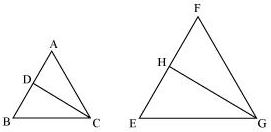
It is given that ΔABC ∼ ΔFEG.
∠A = ∠F, ∠B = ∠E, and ∠ACB = ∠FGE
∠ACB = ∠FGE
∠ACD = ∠FGH (Angle bisector)
And, ∠DCB = ∠HGE (Angle bisector)
In ΔACD and ΔFGH,
∠A = ∠F (Proved above)
∠ACD = ∠FGH (Proved above)
ΔACD ∼ ΔFGH (By AA similarity criterion)
In ΔDCB and ΔHGE,
∠DCB = ∠HGE (Proved above)
∠B = ∠E (Proved above)
ΔDCB ∼ ΔHGE (By AA similarity criterion)
In ΔDCA and ΔHGF,
∠ACD = ∠FGH (Proved above)
∠A = ∠F (Proved above)
ΔDCA ∼ ΔHGF (By AA similarity criterion)
P11. In the following figure, E is a point on side CB produced of an isosceles triangle ABC with AB = AC. If AD ⊥ BC and EF ⊥ AC, prove that ΔABD ∼ ΔECF
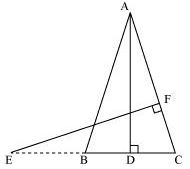
Sol. It is given that ABC is an isosceles triangle.
AB = AC
⇒ ∠ABD = ∠ECF
In ΔABD and ΔECF,
∠ADB = ∠EFC (Each 90°)
∠BAD = ∠CEF (Proved above)
ΔABD ∼ ΔECF (By using AA similarity criterion)
P12. Sides AB and BC and median AD of a triangle ABC are respectively proportional to sides PQ and QR and median PM of ΔPQR (see the given figure). Show that ΔABC ∼ ΔPQR.
Sol. Median divides the opposite side.
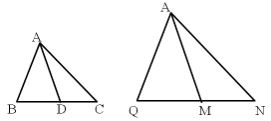
Given that,
In ΔABD and ΔPQM,
(Proved above)
ΔABD ∼ ΔPQM (By SSS similarity criterion)
∠ABD = ∠PQM (Corresponding angles of similar triangles)
In ΔABC and ΔPQR,
∠ABD = ∠PQM (Proved above)
ΔABC ∼ ΔPQR (By SAS similarity criterion)
P13. D is a point on the side BC of a triangle ABC such that ∠ADC = ∠BAC. Show that
Sol. In ΔADC and ΔBAC,
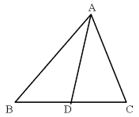
∠ADC = ∠BAC (Given)
∠ACD = ∠BCA (Common angle)
ΔADC ∼ ΔBAC (By AA similarity criterion)
We know that corresponding sides of similar triangles are in proportion.
CA2 = CB × CD
P14. Sides AB and AC and median AD of a triangle ABC are respectively proportional to sides PQ and PR and median PM of another triangle PQR. Show that DABC ∼ DPQR
Sol. Given that,
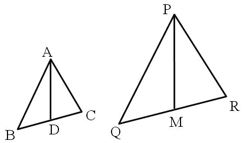
Let us extend AD and PM up to point E and L respectively, such that AD = DE and PM = ML.
Then, join B to E, C to E, Q to L, and R to L
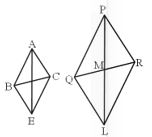
We know that medians divide opposite sides.
Therefore, BD = DC and QM = MR
Also, AD = DE (By construction)
And, PM = ML (By construction)
Therefore, quadrilateral ABEC is a parallelogram.
AC = BE and AB = EC (Opposite sides of a parallelogram are equal)
Similarly, we can prove that quadrilateral PQLR is a parallelogram and PR = QL, PQ = LR
It was given that
ΔABE ∼ ΔPQL (By SSS similarity criterion)
We know that corresponding angles of similar triangles are equal.
∠BAE = ∠QPL …….. (1)
Similarly, it can be proved that ΔAEC ∼ ΔPLR and ∠CAE = ∠RPL …… (2)
Adding equation (1) and (2), we obtain
∠BAE + ∠CAE = ∠QPL + ∠RPL
∠CAB = ∠RPQ …… (3)
In ΔABC and ΔPQR,
∠CAB = ∠RPQ [Using equation (3)]
ΔABC ∼ ΔPQR (By SAS similarity criterion)
P15. A vertical pole of a length 6 m casts a shadow 4m long on the ground and at the same time a tower casts a shadow 28 m long. Find the height of the tower.
Sol. 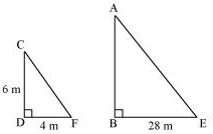
Let AB and CD be a tower and a pole respectively.

Let the shadow of BE and DF be the shadow of AB and CD respectively.
At the same time, the light rays from the sun will fall on the tower and the pole at the same angle.
Therefore, ∠DCF = ∠BAE
and ∠DFC = ∠BEA
∠CDF = ∠ABE
(Tower and pole are vertical to the ground)
ΔABE ∼ ΔCDF (AAA similarity criterion)
AB = 42cm
Therefore, the height of the tower will be 42 metres.
P16. If AD and PM are medians of triangles ABC and PQR, respectively where
ΔABC ∼ ΔPQR prove that
Sol. It is given that ΔABC ∼ ΔPQR
We know that the corresponding sides of similar triangles are in proportion.
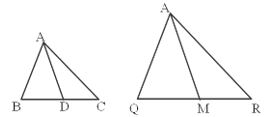
…… (1)
Also, ∠A = ∠P, ∠B = ∠Q, ∠C = ∠R …… (2)
…… (3)
From equations (1) and (3), we obtain
In ΔABD and ΔPQM,
∠B = ∠Q [Using equation (2)]
[Using equation (4)]
ΔABD ∼ ΔPQM (By SAS similarity criterion)
EXERCISE-6.4
P1. Let ΔABC∼ ΔDEF and their areas be, respectively, 64 cm2 and 121 cm2. If EF = 15.4 cm, find BC.
Sol. It is given that ΔABC ~ ΔDEF.
Given that,
EF = 15.4 cm,
ar (ΔABC) = 64 cm2,
ar (DDEF) = 121 cm2,
= (8 × 1.4)cm = 11.2cm
P2. Diagonals of a trapezium ABCD with AB || DC intersect each other at the point O. If AB = 2CD, find the ratio of the areas of triangles AOB and COD.
Sol. Since AB || CD,

∠OAB = ∠OCD and ∠OBA = ∠ODC (Alternate interior angles)
In ΔAOB and ΔCOD,
∠AOB = ∠COD (Vertically opposite angles)
∠OAB = ∠OCD (Alternate interior angles)
∠OBA = ∠ODC (Alternate interior angles)
ΔAOB ∼ ΔCOD (By AAA similarity criterion)
Since AB = 2 CD,
P3. In the following figure, ABC and DBC are two triangles on the same base BC. If AD intersects BC at O, show that
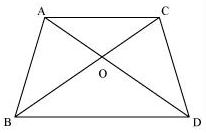
Sol. Let us draw two perpendiculars AP and DM on line BC.
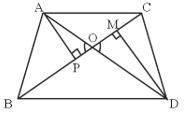
We know that area of a triangle =
In ΔAPO and ΔDMO,
∠APO = ∠DMO (Each = 90°)
∠AOP = ∠DOM (Vertically opposite angles)
ΔAPO ∼ ΔDMO (By AA similarity criterion)
P4. If the areas of two similar triangles are equal, prove that they are congruent.
Sol. Let us assume two similar triangles as ΔABC ∼ ΔPQR.
………….. (1)
Give that,
ar (ΔABC) = ar (ΔPQR)
Putting this value in equation (1), we obtain
AB = PQ, BC = QR and AC = PR
ΔABC = ΔPQR (By SSS congruence criterion)
P5. D, E and F are respectively the mid-points of sides AB, BC and CA of ΔABC. Find the ratio of the area of ΔDEF and ΔABC.
Sol. D and E are the mid-points of ΔABC.
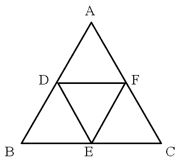
DE || AC and
In ΔBED and ΔBCA, ∠BED = ∠BCA (Corresponding angles)
∠BDE = ∠BAC (Corresponding angles)
∠EBD = ∠CBA (Common angles)
ΔBED ~ ΔBCA (AAA similarity criterion)
Similarity,
ar (ΔCEF)
Also, ar (ΔDEF) = ar(ΔABC) = [ar (ΔBED) + ar(ΔCFE) + ar(ΔADF)]
ar(ΔDEF) = ar(ΔABC)
P6. Prove that the ratio of the areas of two similar triangles is equal to the square of the ratio of their corresponding medians.
Sol. 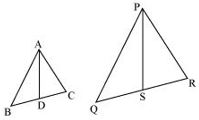
Let us assume two similar triangles as ΔABC ∼ ΔPQR.
Let AD and PS be the medians of these triangles.

ΔABC ∼ ΔPQR
∠A = ∠P, ∠B = ∠Q, ∠C = ∠R… (2)
Since AD and PS are medians,
BD = DC = and, QS =SR =
Equation (1) becomes
In ΔABD and ΔPQS,
∠B = ∠Q [Using equation (2)]
and, [Using equation (3)]
ΔABD ∼ ΔPQS (SAS similarity criterion) Therefore, it can be said that
_____________ (4)
From equations (1) and (4), we may find that
and hence,
P7. Prove that the area of an equilateral triangle described on one side of a square is equal to half the area of the equilateral triangle described on one of its diagonals.
Sol. Let ABCD be a square of side a.
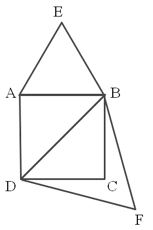
Therefore, its diagonal =
Two desired equilateral triangles are formed as ΔABE and ΔDBF.
Side of an equilateral triangle, ΔABE, described on one of its sides =
Side of an equilateral triangle, ΔDBF, described on one of its diagonals
We know that equilateral triangles have all its angles as 60º and all its sides of the same length.
Therefore, all equilateral triangles are similar to each other.
Hence, the ratio between the areas of these triangles will be equal to the square of the ratio between the sides of these triangles.
P8. ABC and BDE are two equilateral triangles such that D is the mid-point of BC. Ratio of the area of triangles ABC and BDE is
(A) 2 : 1
(B) 1 : 2
(C) 4 : 1
(D) 1 : 4
Sol. We know that equilateral triangles have all its angles as 60º and all its sides of the same length.
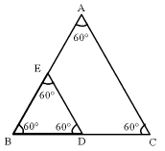
Therefore, all equilateral triangles are similar to each other.
Hence, the ratio between the areas of these triangles will be equal to the square of the ratio between the sides of these triangles.
Let side of ΔABC = x
Therefore, side of
Hence, the correct answer is (C).
P9. Sides of two similar triangles are in the ratio 4 : 9. Areas of these triangles are in the ratio
(A) 2 : 3
(B) 4 : 9
(C) 81 : 16
(D) 16 : 81
Sol. If two triangles are similar to each other, then the ratio of the areas of these triangles will be equal to the square of the ratio of the corresponding sides of these triangles.
It is given that the sides are in the ratio 4:9.
Therefore, ratio between areas of these triangles =
Hence, the correct answer is (D).
EXERCISE-6.5
P1. Sides of triangles are given below. Determine which of them are right triangles? In case of a right triangle, write the length of its hypotenuse.
(i) 7 cm, 24 cm, 25 cm
(ii) 3 cm, 8 cm, 6 cm
(iii) 50 cm, 80 cm, 100 cm
(iv) 13 cm, 12 cm, 5 cm
Sol. (i) It is given that the sides of the triangle are 7 cm, 24 cm, and 25 cm.
Squaring the lengths of these sides, we will obtain 49, 576, and 625.
49 + 576 = 625 Or, 72 + 242 = 252
The sides of the given triangle are satisfying Pythagoras theorem.
Therefore, it is a right triangle.
We know that the longest side of a right triangle is the hypotenuse.
Therefore, the length of the hypotenuse of this triangle is 25 cm.
(ii) It is given that the sides of the triangle are 3 cm, 8 cm, and 6 cm.
Squaring the lengths of these sides, we will obtain 9, 64, and 36.
However, 9 + 36 ≠ 64 or, 32 + 62 ≠ 82
Clearly, the sum of the squares of the lengths of two sides is not equal to the square of the length of the third side.
Therefore, the given triangle is not satisfying Pythagoras theorem.
Hence, it is not a right triangle.
(iii) Given that sides are 50 cm, 80 cm, and 100 cm.
Squaring the lengths of these sides, we will obtain 2500, 6400, and 10000.
However, 2500 + 6400 ≠ 10000 Or, 502 + 802 ≠ 1002
Clearly, the sum of the squares of the lengths of two sides is not equal to the square of the length of the third side.
Therefore, the given triangle is not satisfying Pythagoras theorem.
Hence, it is not a right triangle.
(iv) Given that sides are 13 cm, 12 cm, and 5 cm.
Squaring the lengths of these sides, we will obtain 169, 144, and 25.
Clearly, 144 +25 = 169
Or, 122+52 = 132
The sides of the given triangle are satisfying Pythagoras theorem.
Therefore, it is a right triangle.
We know that the longest side of a right triangle is the hypotenuse.
Therefore, the length of the hypotenuse of this triangle is 13 cm.
P2. PQR is a triangle right angled at P and M is a point on QR such that PM ⊥ QR. Show that PM2 = QM × MR.
Sol. 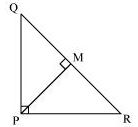
Let ∠MPR = x
In ΔMRP = 180° – 90° – x
∠MRP =90° – x
Similarly, in ΔMPQ,
∠MPQ = 90° – ∠MPR = 90° – x
∠MQP = 180° – 90°- (90° – X)
∠MQP = x
In ΔQMP and ΔPMR,
ΔMPQ = ∠MRP
∠PMQ = ∠RMP
∠MQP = ∠MPR
ΔQMP ~ΔPMR (By AAA similarity criterion)
PM2 = QM ×MR
P3. In the following figure, ABD is a triangle right angled at A and AC ⊥ BD. Show that
(i) AB2 = BC × BD
(ii) AC2 = BC × DC
(iii) AD2 = BD × CD
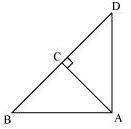
Sol. (i) In ΔADB and ΔCAB,
∠DAB = ∠ACB (Each 90°)
∠ABD = ∠CBA (Common angle)
ΔADB ~ ΔCAB (AA similarity criterion)
AB2 = CB×BD
(ii) Let ∠CAB = x
In ΔCBA,
∠CBA = 180°-90°-x
∠CBA = 90°-x
Similarly, in ΔCAD,
∠CAD = 90° – ∠CAB = 90° – x
∠CDA = 180°- 90° – (90° – x)
∠CDA = x
In ΔCBA and ΔCAD,
∠CBA = ∠CAD,
∠CAB = ∠CDA
∠ACB = ∠DCA (Each 90º)
ΔCBA ~ ΔCAD (By AAA rule)
AC2 = DC × BC
(iii) In ΔDCA and ΔDAD
∠DCA = ∠ DAB (Each 90º)
∠CDA = ∠ ADB (Common angle)
ΔDCA ~ ΔDAB (AASimilarity criterion)
AD2 = BD × CD
P4. ABC is an isosceles triangle right angled at C. prove that AB2 = 2 AC2.
Sol. 
Given that ΔABC is an isosceles triangle.
AC = CB
Applying Pythagoras theorem in ΔABC (i.e., right-angled at point C), we obtain
AC2 + CB2 = AB2
AC2 +AC2 = AB2 (AC = CB)
2 AC2 = AB2
P5. ABC is an isosceles triangle with AC = BC. If AB2 = 2 AC2, prove that ABC is a right triangle.
Sol. 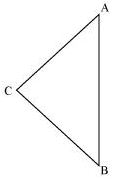
Given that,
AB2 = 2AC2
AB2 = AC2 + AC2
AB2 = AC2 + BC2 (As AC = BC)
The triangle is satisfying the Pythagoras theorem.
Therefore, the given triangle is a right-angled triangle.
P6. ABC is an equilateral triangle of side 2a. Find each of its altitudes.
Sol. 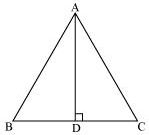
Let AD be the altitude in the given equilateral triangle, ΔABC.
We know that altitude bisects the opposite side.
BD = DC = a
In ΔADB,
∠ADB = 90°
Applying Pythagoras theorem, we obtain
AD2 + DB2 = AB2
AD2 + a2 = (2a)2
AD2 + a2 = 4a2
AD2 = 3a2 AD =
In an equilateral triangle, all the altitudes are equal in length.
Therefore, the length of each altitude will be .
P7. Prove that the sum of the squares of the sides of rhombus is equal to the sum of the squares of its diagonals.
Sol. 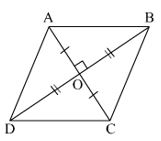
In ΔAOB, ΔBOC, ΔCOD, ΔAOD,
Applying Pythagoras theorem, we obtain
AB2 = AO2 + OB2____ (1)
BC2 = BO2 + OC2____ (2)
CD2 = CO2 + OD2____ (3)
AD2 = AO2 + OD2____ (4)
Adding all these equations, we obtain
AB2 + BC2+ CD2 +AD2 = 2(AO2 + OB2 + OC2 + OD2)
= (Diagonals bisect each other)
=
= (AC)2 + (BD)2
P8. In the following figure, O is a point in the interior of a triangle ABC, OD ⊥ BC, OE ⊥ AC and OF ⊥ AB. Show that
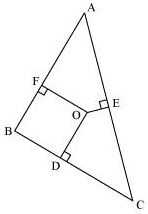
(i) OA2 + OB2 + OC2 − OD2 − OE2 − OF2 = AF2 + BD2 + CE2
(ii) AF2 + BD2 + CE2 = AE2 + CD2 + BF2
Sol. Join OA, OB, and OC.
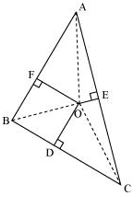
(i) Applying Pythagoras theorem in ΔAOF, we obtain
OA2 = OF2 = AF2
Similarly, in ΔBOD,
OB2 = OD2 + BD2
Similarly, in ΔCOE,
OC2 = OE2 +EC2
Adding these equation,
OA2 +OB2 + OC2 = OF2 + AF2 + OD2 + BD2 + OE2 + EC2
OA2 +OB2 + OC2– OD2 – OE2– OF2 = AF2 + BD2 + EC2
(ii) From the above result,
AF2 + BD2 +EC2 = (OA2 -OE2) + (OC2 -OD2) + (OB2 -OF2)
AF2 +BD2 +EC2 = AE2 + CD2 +BF2
P9. A ladder 10 m long reaches a window 8 m above the ground. Find the distance of the foot of the ladder from base of the wall.
Sol. 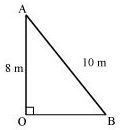
Let OA be the wall and AB be the ladder.
Therefore, by Pythagoras theorem,
AB2 =OA2 +BO2
(10m)2 = (8m)2 +OB2
100m2 = 64m2 + OB2
OB2 = 36m2
OB = 6m
Therefore, the distance of the foot of the ladder from the base of the wall is 6 m.
P10. A guy wire attached to a vertical pole of height 18 m is 24 m long and has a stake attached to the other end. How far from the base of the pole should the stake be driven so that the wire will be taut?
Sol. 
Let OB be the pole and AB be the wire.
By Pythagoras theorem,
AB2 = OB2 + OA2
(24 m)2 = (18m)2 + OA2
OA2 = (578-324)m2 = 252 m2
OA =
Therefore, the distance from the base is .
P11. An aeroplane leaves an airport and flies due north at a speed of 1,000 km per hour. At the same time, another aeroplane leaves the same airport and flies due west at a speed of 1,200 km per hour. How far apart will be the two planes after hours?
Sol. 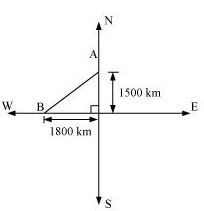
Distance travelled by the plane flying towards north in
Similarly, distance travelled by the plane flying towards west in
Let these distances be represented by OA and OB respectively.
Applying Pythagoras theorem,
Distance between these planes after hrs, AB =
Therefore, the distance between these planes will be after .
P12. Two poles of heights 6 m and 11 m stand on a plane ground. If the distance between the feet of the poles is 12 m, find the distance between their tops.
Sol. 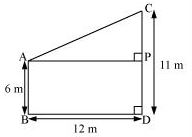
Let CD and AB be the poles of height 11 m and 6 m.
Therefore, CP = 11 − 6 = 5 m
From the figure, it can be observed that AP = 12m
Applying Pythagoras theorem for ΔAPC, we obtain
AP2 +PC2 = AC2
(12m)2 +(5m)2 = AC2
AC2 = (144 + 25)m2 = 169 m2
AC = 13m
Therefore, the distance between their tops is 13 m.
P13. D and E are points on the sides CA and CB respectively of a triangle ABC right angled at C. Prove that AE2 + BD2 = AB2 + DE2
Sol. 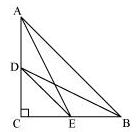
Applying Pythagoras theorem in ΔACE, we obtain
AC2 = CE2 = AE2
Applying Pythagoras theorem in DBCD, we obtain
BC2 + CD2 = BD2
Using equation (1) and equation (2), we obtain
AC2 + CE2 + BC2 + CD2 = AE2 + BD2 _________ (3)
Applying Pythagoras theorem in ΔCDE, we obtain
DE2 = CD2 + CE2
Applying Pythagoras theorem in ΔCDE, we obtain
DE2 = CD2 + CE2
Applying Pythagoras theorem in ΔABC, we obtain
AB2 = AC2 + CB2
Putting the values in equation (3), we obtain
DE2 + AB2 = AE2 + BD2
P14. The perpendicular from A on side BC of a ΔABC intersect BC at D such that DB = 3 CD. Prove that 2 AB2 = 2 AC2 + BC2
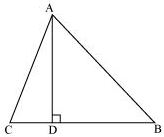
Sol. Applying Pythagoras theorem for ΔACD, we obtain
AC2 = AD2 + DC2
AD2 = AC2 – DC2 _______ (1)
Applying Pythagoras theorem in ΔABD, we obtain
AB2 = AD2 + DB2
AD2 = AB2 – DB2 _______ (2)
From equation (1) and equation (2), we obtain
AC2 – DC2 = AB2 – DB2_______ (3)
It is given that 3DC = DB
DC = and
Putting these values in equation (3), we obtain
16AC2 – BC2 = 16AB2 – 9BC2
16 AB2 – 16AC2 = 8BC2
2AB2 = 2AC2 + BC2
P15. In an equilateral triangle ABC, D is a point on side BC such that BD = BC. Prove that 9 AD2 = 7 AB2.
Sol. 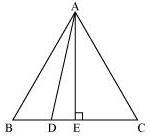
Let the side of the equilateral triangle be a, and AE be the altitude of ΔABC.
BE = EC =
And, AE =
Given that, BD = BC
BD =
DE = BE − BD =
Applying Pythagoras theorem in ΔADE, we obtain
AD2 = AE2 + DE2
=
=
=
⇒ 9 AD2 = 7 AB2
P16. In an equilateral triangle, prove that three times the square of one side is equal to four times the square of one of its altitudes.
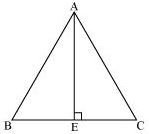
Let the side of the equilateral triangle be a, and AE be the altitude of ΔABC.
BE = EC =
Applying Pythagoras theorem in ΔABE, we obtain
AB2 = AE2 + BE2
4AE2 = 3a2
⇒ 4 × (Square of altitude)
= 3 × (Square of one side)
P17. Tick the correct answer and justify: In ΔABC, AB = cm, AC = 12 cm and BC = 6 cm.
The angle B is:
(A) 120°
(B) 60°
(C) 90°
(D) 45°
Sol. 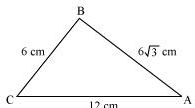
Given that, AB = cm, AC = 12 cm, and BC = 6 cm
It can be observed that
AB2 = 108
AC2 = 144
And, BC2 = 36
AB2 + BC2 = AC2
The given triangle, ΔABC, is satisfying Pythagoras theorem.
Therefore, the triangle is a right triangle, right-angled at B.
∴ ∠B = 90°
Hence, the correct answer is (C).
EXERCISE-6.6
P1. In the given figure, PS is the bisector of ∠QPR of ΔPQR. Prove that .
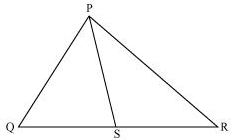
Sol. 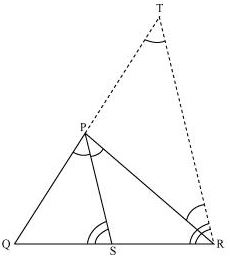
Let us draw a line segment RT
parallel to SP which intersects extended line segment QP at point T.
Given that, PS is the angle bisector of ∠QPR.
∠QPS = ∠SPR … (1)
By construction,
∠SPR = ∠PRT (As PS || TR) … (2)
∠QPS = ∠QTR (As PS || TR) … (3)
Using these equations, we obtain
∠PRT = ∠QTR
PT = PR
By construction,
PS || TR
By using basic proportionality theorem for ΔQTR,
P2. In the given figure, D is a point on hypotenuse AC of ΔABC, DM ⊥ BC and DN ⊥ AB, Prove that:
(i) DM2 = DN.MC
(ii) DN2 = DM.AN
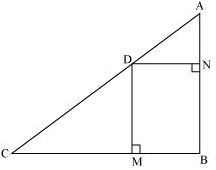
Sol.
(i) Let us join DB.
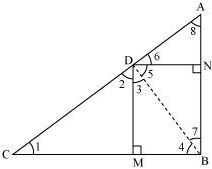
We have, DN || CB, DM || AB, and ∠B = 90°
DMBN is a rectangle.
DN = MB and DM = NB
The condition to be proved is the case when D is the foot of the perpendicular drawn from B to AC.
∠CDB = 90°
⇒ ∠2 + ∠3 = 90° … (1)
In ΔCDM,
∠1 + ∠2 + ∠DMC = 180°
⇒ ∠1 + ∠2 = 90° … (2)
In ΔDMB,
∠3 + ∠DMB + ∠4 = 180°
⇒ ∠3 + ∠4 = 90° … (3)
From equation (1) and (2), we obtain
∠1 = ∠3
From equation (1) and (3), we obtain
∠2 = ∠4
In ΔDCM and ΔBDM,
∠1 = ∠3 (Proved above)
∠2 = ∠4 (Proved above)
ΔDCM ∼ ΔBDM (AA similarity criterion)
⇒ DM2 = DN × MC
(ii) In right triangle DBN,
∠5 + ∠7 = 90° … (4)
In right triangle DAN,
∠6 + ∠8 = 90° … (5)
D is the foot of the perpendicular drawn from B to AC.
∠ADB = 90°
⇒ ∠5 + ∠6 = 90° … (6)
From equation (4) and (6), we obtain
∠6 = ∠7
From equation (5) and (6), we obtain
∠8 = ∠5
In ΔDNA and ΔBND,
∠6 = ∠7 (Proved above)
∠8 = ∠5 (Proved above)
ΔDNA ∼ ΔBND (AA similarity criterion)
⇒ DN2 = AN × NB
⇒ DN2 = AN × DM (As NB = DM)
P3. In the given figure, ABC is a triangle in which ∠ABC > 90° and AD ⊥ CB produced. Prove that AC2 = AB2 + BC2 + 2BC.BD.
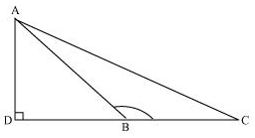
Sol. Applying Pythagoras theorem in ΔADB, we obtain
AB2 = AD2 + DB2 … (1)
Applying Pythagoras theorem in ΔACD, we obtain
AC2 = AD2 + DC2
AC2 = AD2 + (DB + BC)2
AC2 = AD2 + DB2 + BC2 + 2DB × BC
AC2 = AB2 + BC2 + 2DB × BC [Using equation (1)]
P4. In the given figure, ABC is a triangle in which ∠ABC < 90° and AD ⊥ BC. Prove that AC2 = AB2 + BC2 − 2BC.BD.
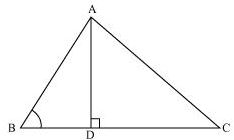
Sol. Applying Pythagoras theorem in ΔADB, we obtain
AD2 + DB2 = AB2
⇒ AD2 = AB2 − DB2 … (1)
Applying Pythagoras theorem in ΔADC, we obtain
AD2 + DC2 = AC2
AB2 − BD2 + DC2 = AC2 [Using equation (1)]
AB2 − BD2 + (BC − BD)2 = AC2
AC2 = AB2 − BD2 + BC2 + BD2 − 2BC × BD = AB2 + BC2 − 2BC × BD
P5. In the given figure, AD is a median of a triangle ABC and AM ⊥ BC. Prove that:
(i)
(ii)
(iii)
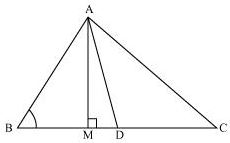
Sol. (i) Applying Pythagoras theorem in ΔAMD, we obtain
AM2 + MD2 = AD2 … (1)
Applying Pythagoras theorem in ΔAMC, we obtain
AM2 + MC2 = AC2
AM2 + (MD + DC)2 = AC2
(AM2 + MD2) + DC2 + 2MD.DC = AC2
AD2 + DC2 + 2MD.DC = AC2 [Using equation (1)]
Using the result, , we obtain
(ii) Applying Pythagoras theorem in ΔABM, we obtain
AB2 = AM2 + MB2
= (AD2 − DM2) + MB2
= (AD2 − DM2) + (BD − MD)2
= AD2 − DM2 + BD2 + MD2 − 2BD × MD
= AD2 + BD2 − 2BD × MD
(iii) Applying Pythagoras theorem in ΔABM, we obtain
AM2 + MB2 = AB2 … (1)
Applying Pythagoras theorem in ΔAMC, we obtain
AM2 + MC2 = AC2 … (2)
Adding equations (1) and (2), we obtain
2AM2 + MB2 + MC2 = AB2 + AC2
2AM2 + (BD − DM)2 + (MD + DC)2 = AB2 + AC2
2AM2+BD2 + DM2 − 2BD.DM + MD2 + DC2 + 2MD.DC = AB2 + AC2
2AM2+2MD2+BD2+DC2 +2MD(−BD+ DC) = AB2 + AC2
P6. Prove that the sum of the squares of the diagonals of parallelogram is equal to the sum of the squares of its sides.
Sol.
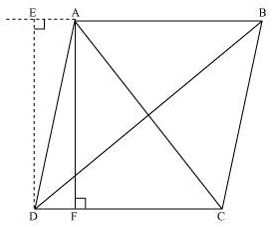
Let ABCD be a parallelogram.
Let us draw perpendicular DE on extended side AB, and AF on side DC.
Applying Pythagoras theorem in ΔDEA, we obtain
DE2 + EA2 = DA2 … (i)
Applying Pythagoras theorem in ΔDEB, we obtain
DE2 + EB2 = DB2
DE2 + (EA + AB)2 = DB2
(DE2 + EA2) + AB2 + 2EA × AB = DB2
DA2 + AB2 + 2EA × AB = DB2 … (ii)
Applying Pythagoras theorem in ΔADF, we obtain
AD2 = AF2 + FD2
Applying Pythagoras theorem in ΔAFC, we obtain
AC2 = AF2 + FC2
= AF2 + (DC − FD)2
= AF2 + DC2 + FD2 − 2DC × FD
= (AF2 + FD2) + DC2 − 2DC × FD
AC2 = AD2 + DC2 − 2DC × FD … (iii)
Since ABCD is a parallelogram,
AB = CD … (iv)
And, BC = AD … (v)
In ΔDEA and ΔADF,
∠DEA = ∠AFD (Both 90°)
∠EAD = ∠ADF (EA || DF)
AD = AD (Common)
ΔEAD ΔFDA (AAS congruence criterion)
⇒ EA = DF … (vi)
Adding equations (i) and (iii), we obtain
DA2 + AB2 + 2EA × AB + AD2 + DC2 − 2DC × FD = DB2 + AC2
DA2 + AB2 + AD2 + DC2 + 2EA × AB − 2DC × FD = DB2 + AC2
BC2 + AB2 + AD2 + DC2 + 2EA × AB − 2AB × EA = DB2 + AC2
[Using equations (iv) and (vi)]
AB2 + BC2 + CD2 + DA2 = AC2 + BD2
P7. In the given figure, two chords AB and CD intersect each other at the point P. prove that:
(i) ΔAPC ∼ ΔDPB
(ii) AP.BP = CP.DP
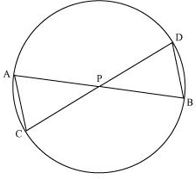
Sol. Let us join CB.
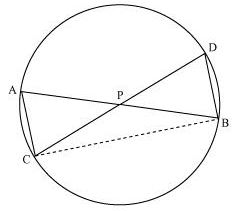
(i) In ΔAPC and ΔDPB,
∠APC = ∠DPB (Vertically opposite angles)
∠CAP = ∠BDP (Angles in the same segment for chord CB)
ΔAPC ∼ ΔDPB (By AA similarity criterion)
(ii) We have already proved that
ΔAPC ∼ ΔDPB
We know that the corresponding sides of similar triangles are proportional.
AP. PB = PC. DP
P8. In the given figure, two chords AB and CD of a circle intersect each other at the point P (when produced) outside the circle. Prove that
(i) ΔPAC ∼ ΔPDB
(ii) PA.PB = PC.PD
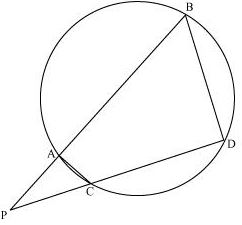
Sol.
(i) In ΔPAC and ΔPDB,
∠P = ∠P (Common)
∠PAC = ∠PDB (Exterior angle of a cyclic quadrilateral is ∠PCA = ∠PBD equal to the opposite interior angle)
ΔPAC ∼ ΔPDB
(ii) We know that the corresponding sides of similar triangles are proportional.
PA.PB = PC.PD
P9. In the given figure, D is a point on side BC of ΔABC such that . Prove that AD is the bisector of ∠BAC.
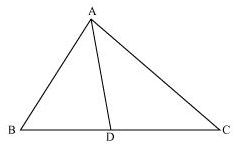
Sol. Let us extend BA to P such that AP = AC. Join PC.
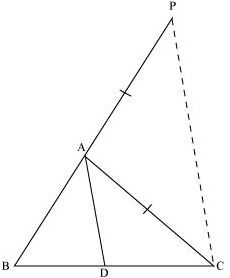
It is given that,
By using the converse of basic proportionality theorem, we obtain
AD || PC
⇒ ∠BAD = ∠APC (Corresponding angles) … (1)
And, ∠DAC = ∠ACP (Alternate interior angles) … (2)
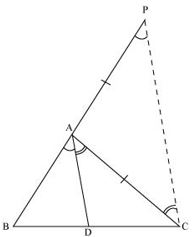
By construction, we have
AP = AC
⇒ ∠APC = ∠ACP … (3)
On comparing equations (1), (2), and (3), we obtain
∠BAD = ∠APC
⇒ AD is the bisector of the angle BAC.
P10. Nazima is fly fishing in a stream. The tip of her fishing rod is 1.8 m above the surface of the water and the fly at the end of the string rests on the water 3.6 m away and 2.4 m from a point directly under the tip of the rod. Assuming that her string (from the tip of her rod to the fly) is taut, ho much string does she have out (see Fig. 6.64)? If she pulls in the string at the rate of 5 cm per second, what will be the horizontal distance of the fly from her after 12 seconds?
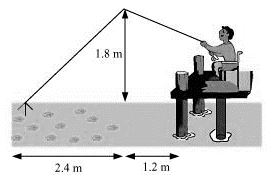
Sol. 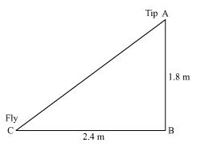
Let AB be the height of the tip of the fishing rod from the water surface. Let BC be the horizontal distance of the fly from the tip of the fishing rod.
Then, AC is the length of the string.
AC can be found by applying Pythagoras theorem in ΔABC.
AC2 = AB2 + BC2
AB2 = (1.8 m)2 + (2.4 m)2
AB2 = (3.24 + 5.76) m2
AB2 = 9.00 m2
Thus, the length of the string out is 3 m.
She pulls the string at the rate of 5 cm per second.
Therefore, string pulled in 12 seconds = 12 × 5 = 60 cm = 0.6 m
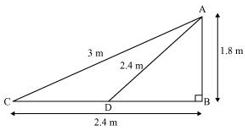
Let the fly be at point D after 12 seconds.
Length of string out after 12 seconds is AD.
AD = AC − String pulled by Nazima in 12 seconds = (3.00 − 0.6) m = 2.4 m
In ΔADB, AB2 + BD2 = AD2
(1.8 m)2 + BD2 = (2.4 m)2
BD2 = (5.76 − 3.24) m2 = 2.52 m2
BD = 1.587 m
Horizontal distance of fly = BD + 1.2 m = (1.587 + 1.2) m= 2.787 m = 2.79 m








